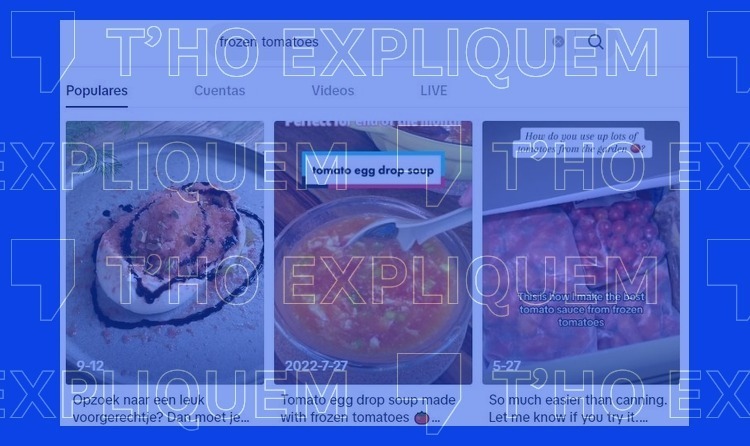Frozen products can be just as healthy or healthier than fresh ones
Recently dozens of TikTok videos have gone viral in which people use frozen tomatoes to …

Recently dozens of TikTok videos have gone viral in which people use frozen tomatoes to dress salads. The social media trend stems from the popular doubt about whether frozen food is just as healthy as fresh food. So the question is: Does freezing food make it lose its nutritional properties?
Frozen products can have nutritional characteristics that are just as good or better than fresh foods. But not all food is suitable for freezing, since some foods’ flavour and texture may lose certain properties in the process. So grating frozen tomatoes is a safe practice nutritionally speaking, but the vegetable’s taste may be different than if it were fresh.
The cold stops enzymes and microorganisms
“If we have access to a garden or local products and we can consume them within a few days, fresh products are always the best option”, Robert Soliva, professor of Food Technology at the University of Lleide (UdL), explains to Verificat. However, if immediate consumption is not possible, freezing the food is the next best option, according to the Spanish Agency for Food Safety and Nutrition (AESAN).
“A fresh vegetable (that is refrigerated) loses part of its nutritional content during storage”, Soliva adds. This occurs because foods contain a series of enzymes that degrade their quality and cause them to lose vitamins as time passes. Freezing products below -18°C stops the action of many of the enzymes, which maintains their nutritional quality for more time. In fact, the frozen vegetables that we buy in the supermarket have an “attractive nutritional content because they were processed right after they were harvested”, the expert stresses.
That being said, “if we want to consume these products after being thawed, they may have become unappealing” in terms of their flavour and texture because “the ice crystals formed during the freezing process have caused changes in the tissue”, Soliva concludes.
Freezing and thawing foods at home
To freeze fresh foods that we will not consume in the near future, the best way to do it is to lower the temperature as quickly as possible. This minimises the formation of ice crystals, structures that form when the water contained inside the food freezes, which can damage and spoil the food.
It is difficult to speed up the freezing process at home, explains Soliva, “because household appliances are not designed speficially for freezing”. The expert gives some suggestions: we can save time by freezing food as soon as it is cut, packaging it in small quantities, and avoiding putting hot foods in the freezer and freezing everything at once.
When we thaw food speed should also be a priority. AESAN recommends either by putting it in the fridge (in the part where the temperature is the lowest), in the microwave or cooking it immediately.
Can we freeze everything?
Another recurring rumour is that, once food has been thawed, it should not be frozen again. While there are some exceptions, it is generally true, Soliva says. “If we refreeze a product that has already been frozen and thawed”, he continues, then it is likely to have a higher microbial load than it had at the start, increasing the possibility that it will be in a bad state when we consume it.
But there are a few exceptions. Refreezing raw or cooked food that has been thawed in the refrigerator is not a problem (although its quality may worsen); it is also safe to freeze cooked food made from raw foods that had been frozen.
Even though proper freezing practices keep foods safe almost indefinitely, for quality reasons, not all foods can be kept frozen for the same amount of time. For example, although it is recommended to avoid freezing stews or soups for more than three months, beef or chicken can be frozen for up to a year without losing their nutritional qualities.